
To borrow a line from Maitland McDonagh, it used to be hip to say that California's three best film schools were UCLA, USC, and RCU-Roger Corman University-and that RCU was the best of the bunch. After all, RCU alumni included Joe Dante, Ron Howard, Jonathan Demme, James Cameron, Gale Anne Hurd, to name a few. Actual collegiate film programs granted you an academic understanding of how to be a filmmaker; Roger Corman University threw you straight into the deep end and gave you instant hands-on experience.
By the time Katt Shea attended RCU in the 1980s, however, the shine was starting to wear off. Due to changes in the industry, Corman's beloved B-Movies were migrating away from drive-in theaters and over to VHS. That meant even smaller budgets, faster shoots, and overall lower quality movies.
Still, Corman was just about the only producer in town willing to hire women for behind the scenes roles. Penelope Spheeris, for example, just had a single documentary to her name when Corman hired her to make her feature-length directorial debut, Suburbia.
So, for someone like Katt Shea, there was no better place to start than RCU. From the age of 12, she was always putting on plays with her friends or shooting random things. By the time she was out of high school, she wanted to become a director. Corman would eventually give her that chance.
She had to fight for it, though.
She had to plead with him for over a year to get her first movie made.
And she had to wear a leotard.
Wait. What?
It's complicated and more innocent than it sounds.
"I got an agent and started going on auditions that had nothing to do with talent. It only had to do with how I looked."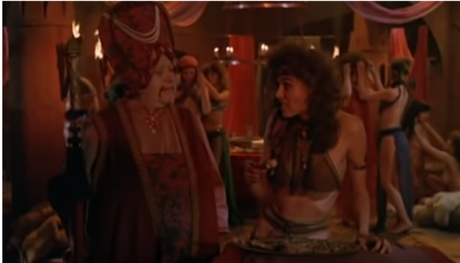
I'll let Shea explain how it came to be, taken from her interview in the oral history/coffee table book Crab Monsters, Teenage Cavemen, and Candy Stripe Nurses: Roger Corman: King of the B Movie:
I was teaching blind kids in a Detroit high school in a really tough neighborhood. I wanted to try something new, so I drove out to Hollywood in my Volkswagen Beetle. I didn't really go with the intention of acting, but I got an agent and started going on auditions that had nothing to do with talent. It only had to do with how I looked. I was sent on an audition for a Roger Corman movie, and I didn't get the part. They actually hired somebody else, but then that actress got a TV pilot, and I was the next in line. It was for Barbarian Queen. I went to Argentina for two and a half months to shoot that. It was a ridiculous sword-and-sandal movie.
For those who don't remember, thanks to Conan the Barbarian the early 80s saw a huge uptick in sword-and-sandal movies. Corman was among the first to jump on the imitation wagon, ordering Jim Wynorski, who had just been hired to work in the studio's advertising department, to come up with a script for what would become 1982's Sorceress.
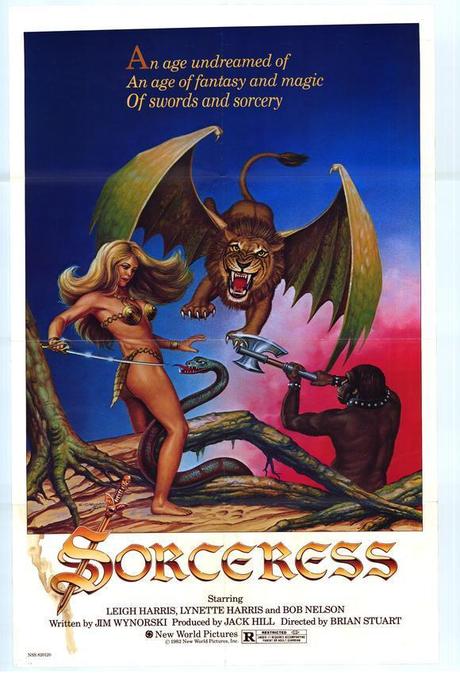
A year later, Corman was at it again, churning out Deathstalker. As Mondo-Digital pointed out, Deathstalker set the template for years to come: "South American filming locations (usually Argentina), endless parades of female flesh, striking Boris Vallejo poster art (either real or imitation), and bizarre plot twists aplenty."
1985's Barbarian Queen ticks all of those boxes. I mean, just look at this "Larry Flynt's wet dream" movie poster:
"It was so ridiculous, you just have to laugh and do your best."
To Shea, Barbarian Queen was just a silly experience:
It was just a wild time. I was one of the barbarians girls in a skimpy little outfit along with Lana Clarkson. She was a very strong girl and very much wanted to be a big, big star. She definitely saw it as her big break. We have our big hair and Cover Girl makeup on I see the pictures now and I go, "Why would they do that to me?" It was so ridiculous, you just have to laugh and do your best.
The film is ultimately a familiar revenge quest story led by a righteously aggrieved Clarkson and Shea. While Clarkson saw it has her breakthrough, Shea certainly could have as well. To that point in Hollywood, she'd scored bit parts in five prior movies. Her first credited appearance was as "Mud Wrestler" in 1983's My Tutor. Playing the co-lead with plenty of lines in Barbarian Queen was a huge step up.
But climbing the ladder as an actress is not what Shea drove out to Hollywood to do. She wanted to do so much more, but because she was attractive she was shoved into skimpy outfits in a series of goofy movies.
To pull out of the cycle, Shea needed to get proactive:
The whole time I wasn't participating in anything movie-wise [on Barbarian Queen], I was asking questions and trying to figure out how they shoot things and how do they decide how to shoot it, and what was their inspiration, and asking the cameraman what kind of lens they were using and why, and all that kind of stuff. After I got back [from Argentina], I started writing screenplays.
The more she learned about filmmaking, the more empowered she felt to make suggestions to other directors. Eventually, they would just give her a camera and let her shoot second unit. Once that happened, Shea's transition away from acting was almost complete.
Immediately after Barbarian Queen, she appeared in two more movies: Psycho III (in which she suffers a truly horrible death at Norman Bates' hands) and The Devastator (a gonzo Rambo knock-off which granted her second billing). Both came out in 1986. She told everyone on Psycho III they were witnessing her swan song as an actress. They didn't believe her, but she was right - she wouldn't act again in a movie she didn't also direct until 2015.
"The girls were just so amazing. I said, 'We have to make a movie about this!'"
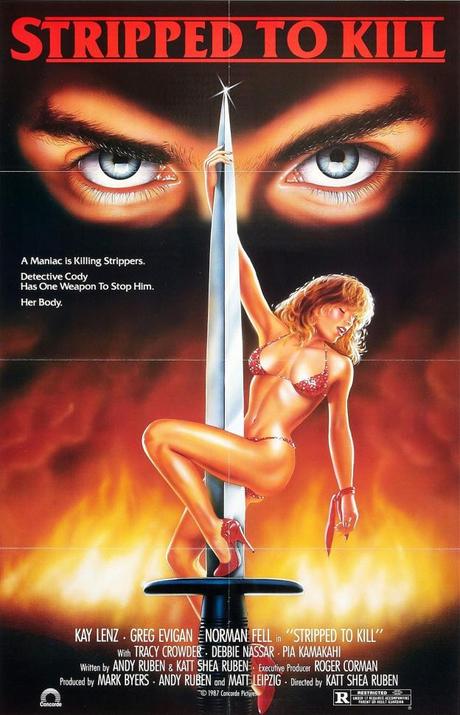
Rarely has a bet between a husband and wife and subsequent trip to a strip club actually changed lives, but that's what exactly what happened to Shea and her husband at the time:
Andy Ruben was my husband and writing partner at the time. We were having dinner one night, and he told me that mussels were poisonous at certain times of the year. I thought he was just screwing with me because I'd never heard that before. So we made a bet, and if I lost, I would have to go to a strip club with him. I didn't want to go and see these women being exploited. But we went to The Body Shop, and I fell in love with it all. The girls were just so amazing. I said, "We have to make a movie about this!" So Andy and I came up with the idea for Stripped to Kill.

The Body Shop, pictured above, was a favorite Motley Crue spot at the time. In 1987, the same year Stripped to Kill came out, it would be one of the seven real strip clubs namechecked in the band's "Girls Girls Girls." The resulting music video mostly entails the Crue riding motorcycles in L.A. like conquering heroes and hitting strip clubs to gawk at half-naked women.
That's what Motley Crue got out of their Body Shop experience. Katt Shea, however, saw a deeper beauty in it. Pragmatically, she also saw something she could sell to Roger.
I approached Roger about it - actually, I waited outside his office for him to come out for lunch one day and "accidentally" bumped into him. I said, "Roger, I've got this fantastic idea for a movie, and it involves strippers! You're not gonna believe it, the fly around this pole, and here's what the poster will look like!" And his eyes are just getting bigger and bigger. So he says, "Come into my office Monday morning." Andy said to me, "When you pitch him, tell him you're gonna direct it." And unbelievably, Roger was open to it.
Why wouldn't he be? The plot Ruben and Shea put together for Stripped to Kill was every B-movie producer's dream at the time: a gorgeous, but closed off female cop (ultimately played by Kay Lenz) goes undercover as a stripper to find a killer. The experience initiates a kind of sexual awakening but also exposes the cop to forces far deadlier than drunk, lonely guys throwing money at her feet.
It's a plot which has been redone countless times since, including in a bizarre gender-reversed TV remake called Ladykillers. It's easy to sell, easy to sum up on a poster, and creates an entirely organic explanation to show boobs.
However, Ruben and Shea had a third act plot twist in mind which beat Crying Game to the punch by five years and completely turned Corman off the project since he doubted audiences would ever buy it.
In the movie, one of the strippers is actually a guy in drag, and Roger didn't think we could pull that off and have it be convincing. So I brought in a female impersonator from La Cage aux Folles, and he explained to Roger what he does with his package when wears a G-string. And he went into such detail that Roger was turning purple, and he says, "Just get out of my office! You can do it, just get out!"
He's going, "I said no!" And I'm like, "Yeah, but we are."
But what Roger giveth he can taketh away. Not too long after that meeting, he changed his mind and canceled the project. According to her recent Shock Waves interview, Shea's still not sure where she got the confidence to do this, but she basically Constanza-ed Corman. After all, can you really fire someone if that person refuses to accept the firing?
When told over the phone that Stripped to Kill wasn't going to happen, Shea simply refused to let Corman back out like that:
I go, "Yes we are. We're doing it! We're doing it!" He's going, "I said no!" And I'm like, "Yeah, but we are, and we're doing it." He finally just hangs up on me and goes, "I guess we're making Stripped to Kill."
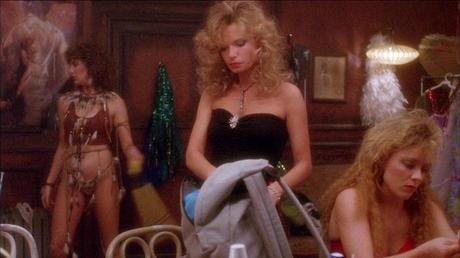
Cast mostly with real strippers and filmed in a real nightclub over 30 days, Stripped to Kill advances the stripping-can-be-empowering message far more convincingly than later male-directed 90s movies like Showgirls and Striptease. Much as some might scoff at the following description, the women in Shea's film are clearly exotic dancers, not just strippers. Her rarely-invasive camera placement, artistically-inclined lighting choices, and abnormally long dance sequences make sure of that.
Beyond that, Stripped to Kill works as an unusually effective thriller. As Mondo-Digital raved, "It's easy to see how Shea earned her stripes here as she injects the film with a lot of wild visual flair and keeps the characters offbeat and intriguing, with the supporting dancers all getting a chance to make an impression and show off some wild routines. Anyone expecting some slasher thrills will come up a bit less satisfied as it only really kicks into gear horror-wise in the last 15 minutes, but the revelation and final showdown are perverse enough to make it worth the wait."
Still, even the Roger Corman book Crab Monsters, Teenage Cavemen, and Candy Stripe Nurses concedes Stripped to Kill isn't for everyone, summing it up thusly: "You're either the audience for this kind of movie or you're not."
Apparently, the people of 1987 fell largely larger into that former category because Stripped to Kill turned into the biggest hit Roger Corman had enjoyed in years. Shea's better-than-expected film quickly rose above the rest of the direct-to-VHS fare of the time, enjoying particular success overseas.
With that, Katt Shea's new life as a film director had truly begun.
"OK, Roger, I'm taking my name off!"
It wasn't easy getting there, obviously. Corman didn't much like the first two-hour cut of Stripped to Kill and forced his way into the editing room. It seemed as if he would never agree to work with Shea again.
But success changes everything. Shea was welcomed back into the fold after Stripped to Kill 's big business and offered a very familiar Roger Corman storytelling challenge: What can you do with these pre-existing sets before we have to tear them down?
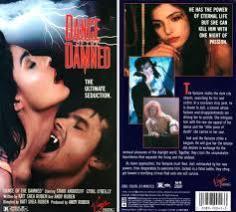
Dance of the Damned, for example, came about because Corman wanted to somehow combine a strip club set with a gothic castle set. So, Shea and Ruben came up with a plot about a vampire targeting a suicidal stripper. A Stripped to Kill sequel, 1989's Stripped to Kill II: Live Girls, happened immediately after that - as in they had to write and cast the thing over a single weekend - because Corman realized they had five days left before they needed to tear down the Dance of the Damned strip club set. Why just let it stand there unused?
It's enough to drive anyone insane. "I threatened to take my name off every movie I did for [Corman] At the end, he would be driving me so crazy with the editing and putting more boobs in and everything, I would go, 'OK, Roger, I'm taking my name off!'"
In 1990, Shea's stretch of stripper movies finally came to an end. With Streets, she stayed in the LA underworld but explored the plight of the homeless at the time, casting a young Christina Applegate as her lead:
Streets would prove to be the project which finally led to Shea's graduation from Roger Corman University. Based on that movie, New Line and Bob Shaye heavily pursued her and Andy Ruben, pairing them with executive producer Melissa Goddard, whose life story formed the basis for what eventually became Poison Ivy.
Another B-movie elevated by Shea's unique talents, Peter Travers summed up Poison Ivy perfectly, "Movie snobs can laugh, but Shae has a gift for transcending pulp. The emotional resonance, visual sophistication, and feminist subtext of her work create a distinctive style worth monitoring."
Right you are, Travers. After Poison Ivy, Shea's career skyrocketed. She was behind the camera of some great Geena Davis movies, came pretty close to an Oscar nomination a couple of times, and truly graduated to the big time when she brought her impeccable eye to Jennifer Garner's classic female superhero movie Elektra. Just like Sam Raimi's transition from B-movie fame to mainstream stardom, she entered the pantheon of worldwide known film directors.
Oh, wait. None of that happened. I mean, it some alternate universe it certainly could have, but not in 1990s Hollywood.
"The thing that was hard about going back is just the lack of money and the struggle."
For six years after Poison Ivy, Shea met with every producer and studio imaginable. Sometimes they would pay her to write something for them or re-write something they already had. Nothing ever moved past that. It got to the point that her agent told her to cut her hair so as to seem more masculine and thus more hirable as a director. That didn't work either.
The only person who would hire her to direct? Roger Corman.
After I made the Stripped to Kill movies and Streets for Roger, I went off and made Poison Ivy. It felt like I had graduated to the big time. But then I came back to make Last Exit to Earth. The thing that was hard about going back is just the lack of money and the struggle. People have no idea, the miracles that were created on nothing.
Her next movie, 1999's The Rage: Carrie 2, only happened because the producers fired the first director and were desperate to salvage something out of the mess rather than cancel the film entirely.
A decade of sporadic TV movies ensued, and in the face of such inconsistent work she diversified and opened an acting school.
Sadly, it's a familiar story among many of the women who got their start working for Corman: The opportunities he made available to them weren't as easily found elsewhere in town, regardless of how profitable their little Corman movies were. It's partially why fellow RCU alumni Penelope Spheeris, who at least got to make Wayne's World and Black Sheep in her post-Corman days, recently told the AVClub, "[Hollywood] can blow me."
Shea's more diplomatic and simply glad to have known and worked with Corman, "If Roger's the guy that you have to answer to for the rest of your life, there's nothing wrong with that. You know where you stand with him. He's a gentleman, and he's honest."
If that was to be the end of it for Shea, so be it.
But after nearly two decades away from the scene, an old admirer of Shea's named Jeff Kleeman tracked her down with an offer to make Nancy Drew and the Hidden Staircase. Not only that, it's a project which comes with Ellen Degeneres attached as a producer!
It's a reminder that as we continue to advocate for more opportunities for female directors there's also a past generation of talented women who never quite got a fair shake. Spheeris might have no interest in making a movie ever again, but Shea made a Nancy Drew movie after 17 years away and would love to keep working. Who else out there wants a similar opportunity?
Stripped to Kill is currently available to stream on Amazon Prime.Sources: The X List: The National Society of Film Critics' Guide to the Movies That Turns Us On, ShockWaves Podcast, Crab Monsters, Teenage Cavemen, and Candy Stripe Nurses: Roger Corman: King of the B Movie by Chris Nashawaty

Grew up obsessing over movies and TV shows. Worked in a video store. Minored in film at college because my college didn't offer a film major. Worked in academia for a while. Have been freelance writing and running this blog since 2013. View all posts by Kelly Konda

